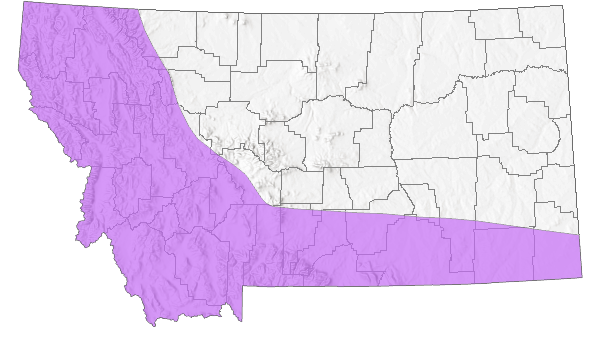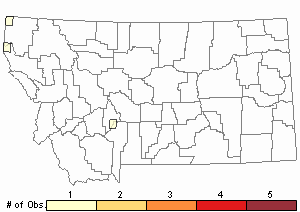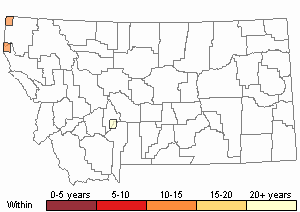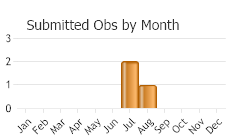View in other NatureServe Network Field Guides
NatureServe
Montana
Utah
Wyoming
Idaho
Wisconsin
British Columbia
South Carolina
Yukon
California
New York
Mitered Vertigo - Vertigo modesta concinnula
Other Names:
Pupa ingersolli
General Description
A small shell, to 1.2 mm diameter and 2.3 mm in height, subcylindrical (pupiform) and slightly tapering with moderate and irregular striae, about 5 whorls. Shell coloration is translucent and dull reddish-brown, sometimes with paler flecks. Aperture subovate, with 5 teeth (parietal, columellar, upper palatal, lower palatal, angular), palatal callus absent, but parietal and palatal teeth elongate, sinulus absent or very weak, crest moderate to well-developed (Hendricks 2012, Burke 2013).
Diagnostic Characteristics
Combination of size (height < 3.0 mm) and shape, presence of teeth in a subovate aperture, 4-5 whorls, and an indentation in palatal lip distinguish Vertigo from similar appearing shells. A sinulus only weakly indented (or not at all) and absence of a palatal callus distinguishish V. concinulla from all but V. modesta, which is slightly larger (height to 2.7 mm) and with a less developed crest. Local variation in the number of teeth is not uncommon. V. concinulla has 5 teeth, V. modesta may have up to 4-5 teeth, but many in Montana have only 2 teeth.
Species Range
Montana Range
Range Descriptions

 Native
Native
Range Comments
Native to North America; primarily in Rocky Mountains from Idaho to Arizona and New Mexico but also Oregon and South Dakota. In Montana, one report east of the Continental Divide, from Gallatin County: elevation 1158 m (3800 ft). Range and abundance in Montana poorly understood; current status needs investigation (Hendricks 2012).
Observations in Montana Natural Heritage Program Database
Number of Observations: 3
(Click on the following maps and charts to see full sized version)
Map Help and Descriptions
Relative Density

Recency



 (Observations spanning multiple months or years are excluded from time charts)
(Observations spanning multiple months or years are excluded from time charts)
Habitat
Not described for Montana (Hendricks 2012). Moist sites in aspen and riparian willow thickets in Wyoming. Found under woody debris and leaf litter (Beetle 1961, 1989).
References
- Literature Cited AboveLegend:
 View Online Publication
View Online Publication Beetle, D. E. 1961. Mollusca of the Big Horn Mountains. The Nautilus 74:95-102.
Beetle, D. E. 1961. Mollusca of the Big Horn Mountains. The Nautilus 74:95-102. Beetle, D.E. 1989. Checklist of recent Mollusca of Wyoming, U.S.A. The Great Basin Naturalist 49(4):637-645.
Beetle, D.E. 1989. Checklist of recent Mollusca of Wyoming, U.S.A. The Great Basin Naturalist 49(4):637-645. Burke, T. E. 2013. Land snails and slugs of the Pacific Northwest. Corvallis, OR: Oregon State University Press. 344 p.
Burke, T. E. 2013. Land snails and slugs of the Pacific Northwest. Corvallis, OR: Oregon State University Press. 344 p. Hendricks, P. 2012. A Guide to the Land Snails and Slugs of Montana. A report to the U.S. Forest Service - Region 1. Montana Natural Heritage Program, Helena, MT. vii + 187 pp. plus appendices.
Hendricks, P. 2012. A Guide to the Land Snails and Slugs of Montana. A report to the U.S. Forest Service - Region 1. Montana Natural Heritage Program, Helena, MT. vii + 187 pp. plus appendices.
- Additional ReferencesLegend:
 View Online Publication
View Online Publication
Do you know of a citation we're missing? Frest, T.J. and E.J. Johannes. 2001. An annotated checklist of Idaho land and freshwater mollusks. Journal of the Idaho Academy of Science 36(2):1-51.
Frest, T.J. and E.J. Johannes. 2001. An annotated checklist of Idaho land and freshwater mollusks. Journal of the Idaho Academy of Science 36(2):1-51. Henderson, J. 1924. Mollusca of Colorado, Utah, Montana, Idaho, and Wyoming. University of Colorado Studies 13(2):65-223.
Henderson, J. 1924. Mollusca of Colorado, Utah, Montana, Idaho, and Wyoming. University of Colorado Studies 13(2):65-223. Henderson, J. 1936. Mollusca of Colorado, Utah, Montana, Idaho, and Wyoming, supplement. University of Colorado Studies 23(2): 81-145.
Henderson, J. 1936. Mollusca of Colorado, Utah, Montana, Idaho, and Wyoming, supplement. University of Colorado Studies 23(2): 81-145. Pilsbry, H.A. 1948. Land Mollusca of North America (north of Mexico), Volume II Part 2. The Academy of Natural Sciences of Philadelphia Monograph Number 2(2): 521-1113.
Pilsbry, H.A. 1948. Land Mollusca of North America (north of Mexico), Volume II Part 2. The Academy of Natural Sciences of Philadelphia Monograph Number 2(2): 521-1113.
- Web Search Engines for Articles on "Mitered Vertigo"
- Additional Sources of Information Related to "Snails / Slugs"





